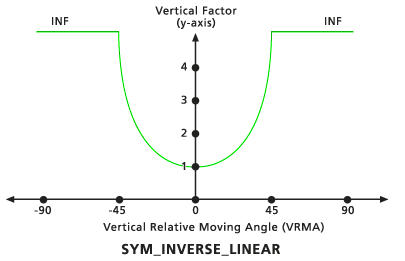Disponible con una licencia de Spatial Analyst.
Resumen
Defines the relationship between the vertical cost factor and the vertical relative moving angle (VRMA) through a symmetrical inverse linear function in either the negative or positive side of the VRMA, respectively. The two linear functions are symmetrical with respect to the VF (y) axis.
Ilustración

Debate
The VfSymInverseLinear object is used in the Spatial Analyst tools Path Distance, Path Distance Allocation, and Path Distance Back Link.
The vertical factor (VF) object defines the relationship between the vertical cost factor and the vertical relative moving angle (VRMA).
VF defines the vertical difficulty encountered in moving from one cell to the next.
VRMA identifies the slope angle between the FROM or processing cell and the TO cell.
The VfSymInverseLinear class, as its name implies, is the inverse of the VfSymLinear vertical factor class. It is composed of two inverse linear functions relative to the VRMAs, which are symmetrical to the VF (y) axis. Both lines intercept the y-axis at the zeroFactor. The slope of the lines is defined as a single slope relative to the positive VRMA using the slope vertical factor argument, which is mirrored to the negative VRMAs.
Sintaxis
VfSymInverseLinear ({zeroFactor}, {lowCutAngle}, {highCutAngle}, {slope})| Parámetro | Explicación | Tipo de datos |
zeroFactor | The zeroFactor will be used to position the y-intercept of the symmetric inverse linear function. (El valor predeterminado es 1.0) | Double |
lowCutAngle | The VRMA degree defining the lower threshold, below which (less than) the VFs are set to infinity. (El valor predeterminado es -45.0) | Double |
highCutAngle | The VRMA degree defining the upper threshold, beyond which (larger than) the VFs are set to infinity. (El valor predeterminado es 45.0) | Double |
slope | Identifies the slope of the straight line in the VRMA-VF coordinate system. Slope is specified as the rise/run. For example, a 30-degree slope is 1/30, specified as 0.03333 (rise/run: 1 VF on the y axis / 30 degrees on the x axis); a -45-degree slope as -0.022222. (El valor predeterminado es -0.022222) | Double |
Propiedades
| Propiedad | Explicación | Tipo de datos |
| zeroFactor (Lectura y escritura) | The zeroFactor is used to position the y-intercept for the vertical factor class. | Double |
| lowCutAngle (Lectura y escritura) | The VRMA degree defining the lower threshold, below which (less than) the VFs are set to infinity. | Double |
| highCutAngle (Lectura y escritura) | The VRMA degree defining the upper threshold, beyond which (larger than) the VFs are set to infinity. | Double |
| slope (Lectura y escritura) | Identifies the slope of the straight line in the VRMA-VF coordinate system. Slope is specified as the rise over the run. For example, a 30-degree slope is 1/30, specified as 0.03333 (rise/run: 1 VF on the y axis / 30 degrees on the x axis); a 90-degree slope as 0.011111. | Double |
Ejemplo de código
VFSymInverseLinear example 1 (Python window)
Demonstrates how to create a VfSymInverseLinear class and use it in the PathDistance tool within the Python window.
import arcpy
from arcpy import env
from arcpy.sa import *
env.workspace = "C:/sapyexamples/data"
myVerticalFactor = VfSymInverseLinear(1.0, -45, 45, -0.02222)
outPathDist = PathDistance("source.shp", "costraster", "", "", "", "",
myVerticalFactor)
outPathDist.save("C:/sapyexamples/output/pathdisvfsil")
VFSymInverseLinear example 2 (stand-alone script)
Performs a PathDistance analysis using the VfSymInverseLinear class.
# Name: VfInverseLinear_Ex_02.py
# Description: Uses the VfInverseLinear object to execute the PathDistance tool.
# Requirements: Spatial Analyst Extension
# Import system modules
import arcpy
from arcpy import env
from arcpy.sa import *
# Set environment settings
env.workspace = "C:/sapyexamples/data"
# Set local variables
inSourceData = "source.shp"
inCostRaster = "costraster"
# Create the VfInverseLinear Object
zeroFactor = 1.0
lowCutAngle = -45
highCutAngle = 45
slope = -0.02222
myVerticalFactor = VfInverseLinear(zeroFactor, lowCutAngle, highCutAngle,
slope)
# Check out the ArcGIS Spatial Analyst extension license
arcpy.CheckOutExtension("Spatial")
# Execute PathDistance
outPathDist = PathDistance(inSourceData, inCostRaster, "", "", "", "",
myVerticalFactor)
# Save the output
outPathDist.save("C:/sapyexamples/output/pathdistvfil2")